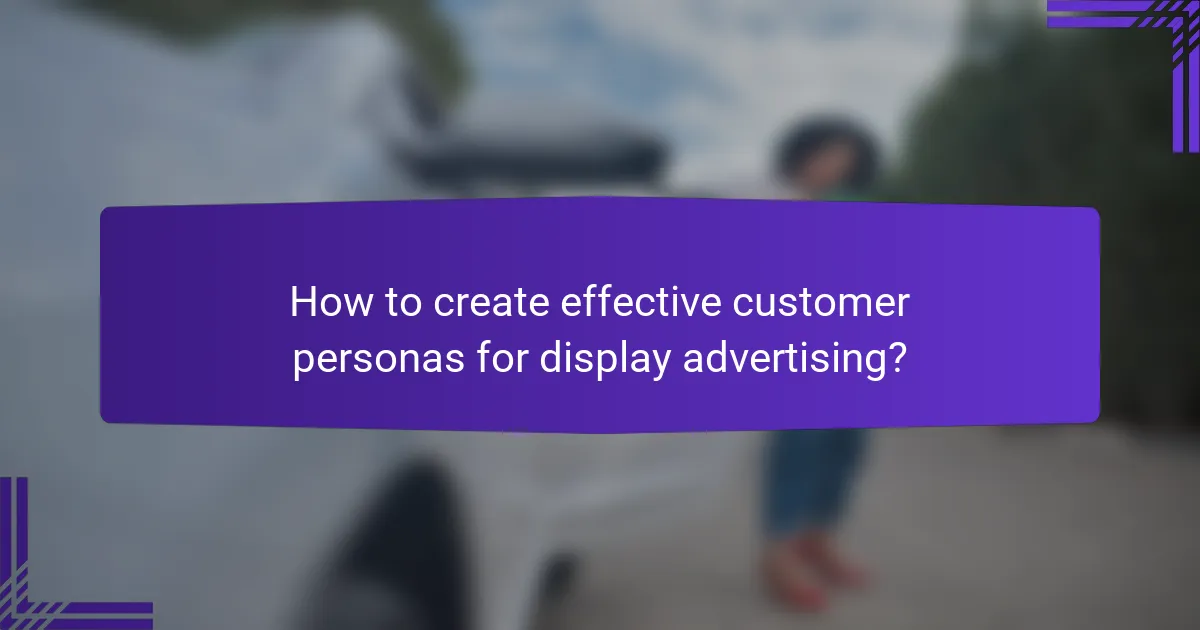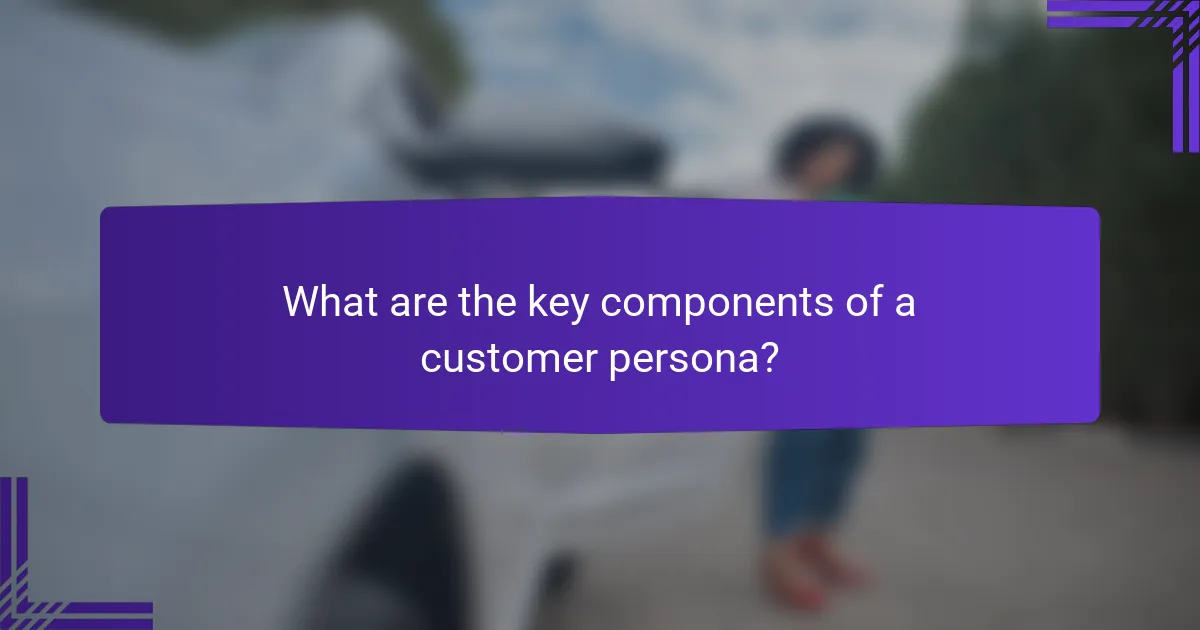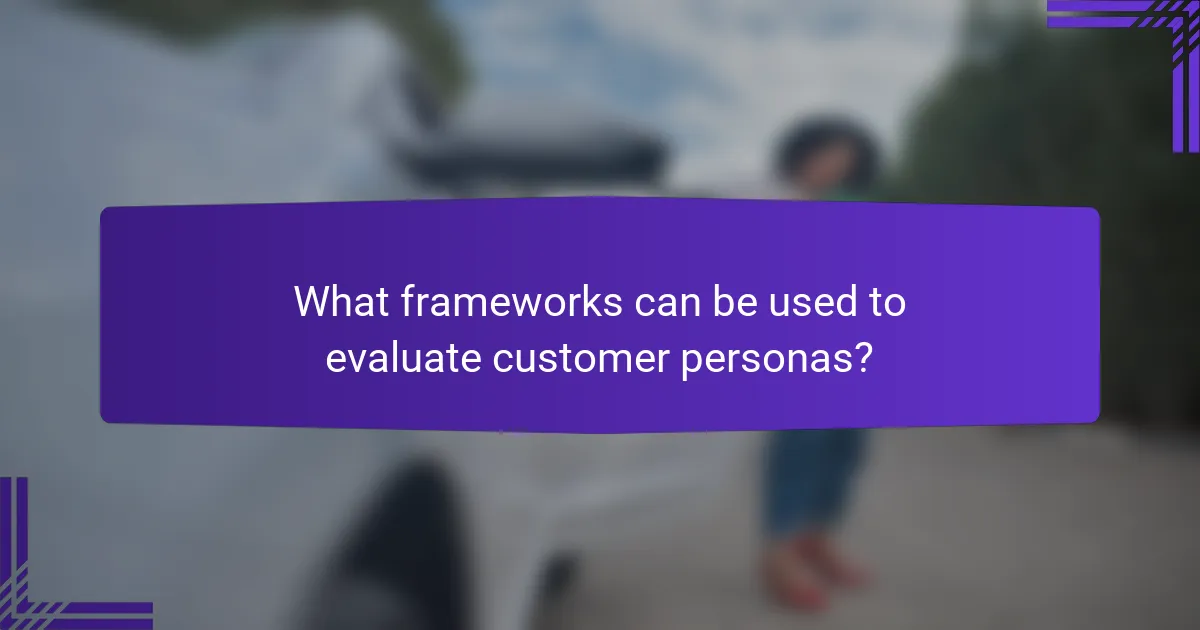Customer personas are essential tools for businesses aiming to enhance their display advertising strategies. By creating semi-fictional representations of ideal customers based on data and research, marketers can gain insights into demographics, preferences, and behaviors. This understanding allows for the development of tailored advertising campaigns that resonate with specific audience segments, ultimately leading to improved engagement and conversion rates.

How to create effective customer personas for display advertising?
Creating effective customer personas for display advertising involves understanding your target audience’s characteristics, preferences, and behaviors. This process helps tailor your advertising strategies to resonate with specific groups, ultimately improving engagement and conversion rates.
Identify target audience demographics
Start by defining the key demographics of your target audience, including age, gender, income level, education, and location. These factors influence purchasing decisions and can help segment your audience into distinct personas. For example, a luxury product may appeal more to individuals aged 30-50 with higher income levels.
Consider using tools like census data or market research reports to gather accurate demographic information. This foundational data will guide your advertising strategies and ensure your messages reach the right people.
Conduct surveys and interviews
Surveys and interviews are effective methods for gathering qualitative insights about your audience. Create structured questionnaires that explore customer preferences, motivations, and pain points. Aim for a diverse sample to capture a broad range of perspectives.
In-person interviews can provide deeper insights, allowing for follow-up questions and clarifications. Use open-ended questions to encourage detailed responses, which can reveal valuable information about customer needs and expectations.
Analyze customer data and behavior
Review existing customer data to identify patterns in purchasing behavior and preferences. Look for trends in product usage, frequency of purchases, and customer feedback. This analysis can help you understand what drives customer loyalty and satisfaction.
Utilize segmentation techniques to categorize customers based on their behavior. For instance, frequent buyers may have different needs compared to occasional shoppers, allowing you to create tailored personas for each group.
Utilize tools like HubSpot and Google Analytics
Leverage tools such as HubSpot and Google Analytics to gather and analyze data on customer interactions with your brand. These platforms provide insights into website traffic, user behavior, and conversion rates, which are crucial for persona development.
Set up tracking for specific actions, such as clicks on ads or product views, to gain a clearer picture of customer engagement. This data can inform your advertising strategies and help refine your customer personas over time.

What are the key components of a customer persona?
A customer persona is a semi-fictional representation of your ideal customer, built from data and research. The key components include demographics, psychographics, goals, challenges, and preferred communication channels, all of which help businesses tailor their marketing strategies effectively.
Demographics and psychographics
Demographics refer to statistical characteristics of a population, such as age, gender, income, education, and location. Psychographics delve deeper into the personality traits, values, interests, and lifestyles of your target audience. Together, these components create a comprehensive picture of who your customers are.
For example, a tech company might identify its customer persona as a 30-40 year old male, college-educated, with a household income of $75,000-$100,000, who values innovation and sustainability. This information helps in crafting targeted marketing messages.
Goals and challenges
Understanding the goals and challenges of your customer persona is crucial for effective marketing. Goals are the desired outcomes your customers seek, while challenges are the obstacles they face in achieving those goals. Identifying these aspects allows businesses to position their products or services as solutions.
For instance, a fitness brand may find that its persona aims to lose weight but struggles with time management. By addressing these challenges in marketing campaigns, the brand can resonate more deeply with potential customers.
Preferred communication channels
Preferred communication channels refer to the platforms and methods through which your customer persona prefers to receive information. This could include email, social media, phone calls, or in-person interactions. Knowing these channels helps businesses reach their audience effectively.
For example, younger audiences may favor Instagram and TikTok, while older demographics might prefer email newsletters or Facebook. Tailoring your communication strategy to these preferences can significantly enhance engagement and conversion rates.

How do customer personas enhance display advertising strategies?
Customer personas significantly enhance display advertising strategies by allowing marketers to tailor their campaigns to specific audience segments. By understanding the characteristics, preferences, and behaviors of different personas, advertisers can create more relevant and effective ads that resonate with their target audience.
Improved ad targeting and relevance
Creating customer personas enables advertisers to improve ad targeting by focusing on the specific needs and interests of distinct groups. This targeted approach ensures that ads are shown to individuals who are more likely to engage with the content, thereby increasing the relevance of the advertisements.
For example, a brand selling outdoor gear can develop personas for avid hikers, casual campers, and families looking for recreational activities. Each persona can then receive tailored ads that highlight products suited to their unique preferences, leading to more effective campaigns.
Higher engagement and conversion rates
When ads are aligned with customer personas, engagement rates tend to increase, leading to higher conversion rates. By delivering personalized content that speaks directly to the interests of the audience, advertisers can capture attention more effectively.
For instance, a campaign targeting tech-savvy millennials with innovative gadgets may see engagement rates in the high double digits, compared to generic ads that might only achieve single-digit responses. Personalization can significantly drive action, encouraging users to click through and make purchases.
Better alignment with customer needs
Customer personas help advertisers align their strategies with the actual needs and pain points of their target audience. By understanding what motivates different personas, brands can craft messages that resonate and address specific challenges.
For example, a financial service targeting young professionals might focus on student loan management and budgeting tools, while a service aimed at retirees could emphasize wealth management and retirement planning. This alignment fosters trust and builds long-term customer relationships.

What frameworks can be used to evaluate customer personas?
To evaluate customer personas effectively, frameworks such as qualitative research, quantitative analysis, and A/B testing can be utilized. These methods help in understanding customer behaviors, preferences, and the overall effectiveness of the personas in guiding marketing strategies.
Persona validation through A/B testing
A/B testing allows businesses to compare two versions of a marketing element to determine which performs better with a target audience. By applying different customer personas to distinct marketing strategies, companies can measure engagement metrics such as click-through rates and conversion rates.
For instance, a company might test two email campaigns: one tailored to a tech-savvy persona and another aimed at a budget-conscious persona. Analyzing the results can reveal which persona resonates more, guiding future marketing efforts.
Feedback loops for continuous improvement
Establishing feedback loops is crucial for refining customer personas over time. Gathering insights from customer interactions, surveys, and sales data can help identify shifts in preferences or behaviors that may necessitate adjustments to the personas.
For example, regularly soliciting feedback through post-purchase surveys can provide valuable data on customer satisfaction and expectations. This information can then be used to enhance the accuracy of personas and ensure they remain relevant in a changing market.

What are the common mistakes in creating customer personas?
Common mistakes in creating customer personas include overgeneralization of audience segments and neglecting data-driven insights. These errors can lead to ineffective marketing strategies and missed opportunities to connect with target customers.
Overgeneralization of audience segments
Overgeneralization occurs when businesses create personas that are too broad, failing to capture the nuances of different customer groups. This can result in a one-size-fits-all approach that does not resonate with specific audiences.
To avoid this mistake, segment your audience based on key characteristics such as demographics, behaviors, and preferences. For example, instead of categorizing all millennials together, consider factors like income level or lifestyle choices to create more tailored personas.
Neglecting data-driven insights
Neglecting data-driven insights means relying solely on assumptions or anecdotal evidence rather than utilizing actual customer data. This can lead to inaccurate personas that do not reflect the true needs and behaviors of your audience.
Incorporate quantitative data from surveys, website analytics, and customer feedback to inform your personas. For instance, analyzing purchase patterns can reveal which products appeal to specific segments, allowing for more targeted marketing efforts.
